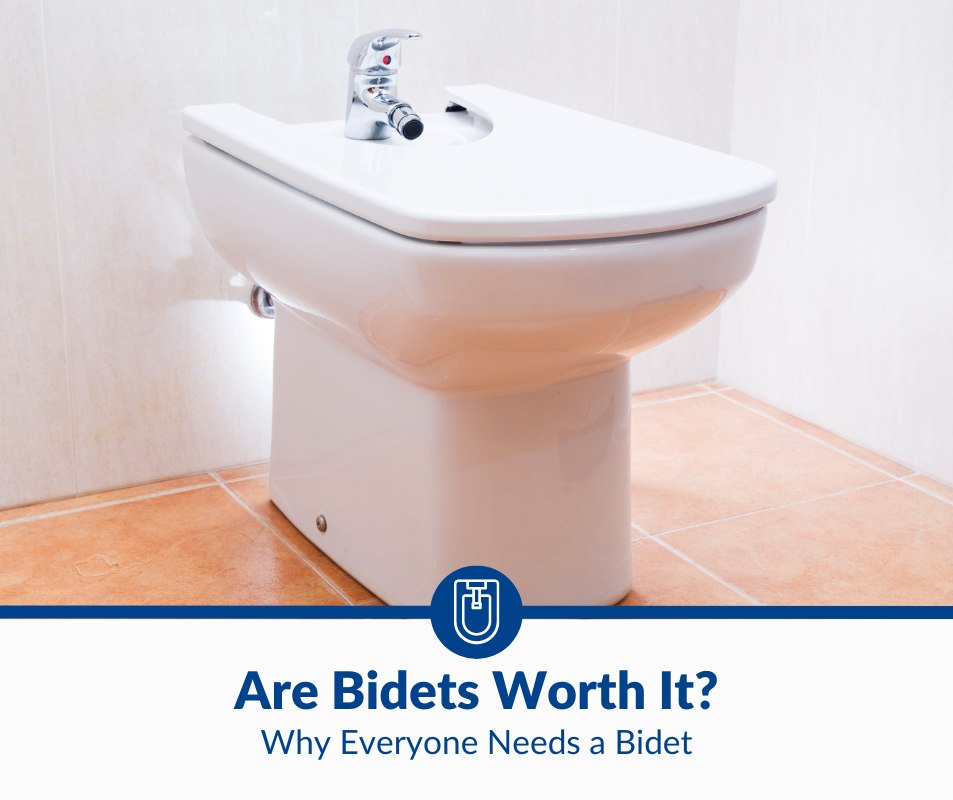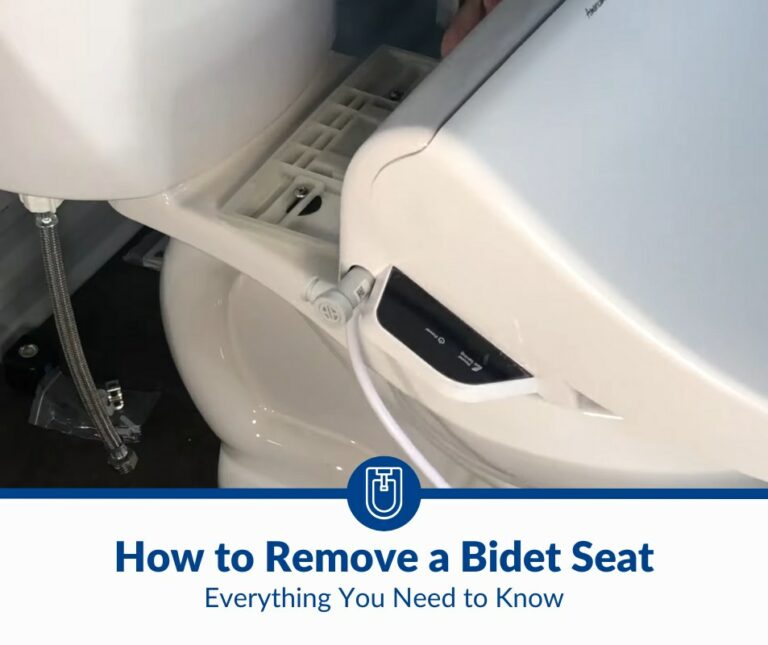Are Bidets Worth It? Why Everyone Needs a Bidet
When updating your bathroom, installing a bidet might cross your mind. Since they’ve become increasingly popular recently, you might wonder if it’s worth adding one to your bathroom. What’s the verdict?
Bidets are worth it if you want a more hygienic clean after using the bathroom, you want to reduce your toilet paper use, and you want to alleviate hemorrhoids or other medical conditions. However, bidets take up a lot of space and can be costly. Ultimately, it’s a personal choice.
This article will describe the pros and cons of using bidets. I’ll also explain why you should consider one and the reasons not to. Let’s get started!
Pros of Using Bidets
- Bidets are more hygienic than regular toilets. Since they use a water stream to clean you after using the toilet, bidets are more hygienic than regular toilets. Using only toilet paper to clean yourself after using the toilet can leave some waste product residue behind. A bidet’s water stream more effectively cleanses away bacteria and can reach more difficult areas. Bidets also keep your hands cleaner.
- Bidets save you money on toilet paper. Despite its initial and costly investment, using a bidet can save you money on toilet paper. Although you’ll use a little toilet paper to dry yourself after using the bidet, it’s negligible compared to what you use with a regular toilet.
- Using a bidet can prevent skin irritation. Using even the best quality and softest toilet tissue can irritate your skin if you use it often enough. This isn’t an issue with a bidet, which uses water instead of toilet paper.
- A bidet can help relieve various conditions. If you have hemorrhoids, using toilet paper can be painful, but a bidet can relieve the irritation with the water’s gentle pressure. The water spray also stimulates the nerve endings around the anus, which may help relieve constipation.
- Bidets can be helpful for people with mobility issues or certain medical conditions. If you have a chronic illness, are elderly, or have a physical disability, using a regular toilet can be challenging. A bidet can make things easier for you by cleaning you after using the toilet.
- Bidets are better for the environment. If you’re concerned about your impact on the environment, a bidet is a great option. You’ll use far less paper and a minimal amount of water.
- A bidet can add value to your home. Having a built-in bidet in your bathroom may increase its value. Bidets are becoming increasingly popular, and your bidet could be a selling point in the future.
Cons of Using Bidets
- Bidets take up a lot of space in the bathroom. Installing a built-in bidet in your bathroom requires as much space as a regular toilet. If your bathroom is small, this may not be an option. Alternatively, you’ll need to settle for a more portable bidet type.
- Bidet installation is complex. If you decide to install a built-in bidet in your bathroom, you’ll need to have separate plumbing for it. This makes installation complex, and you may need to call a professional.
- Using a bidet can be uncomfortable if you’re not used to it. In the West, most people are accustomed to using regular toilets and toilet paper. Using a bidet is very different and can make some people feel uncomfortable.
- Bidets can harbor bacteria and other pathogens. Although bidets are hygienic, they can harbor bacteria if you don’t clean them regularly. Thankfully, cleaning them is simple.
- Women can contract vaginal infections and UTIs from bidets. Research has revealed that women who use bidets are more likely to develop vaginal infections and UTIs than regular toilet users. Bidets may also alter the levels of healthy vaginal bacteria.
- A built-in bidet is unsuitable for rental properties. If you’re renting your home, your landlord may not allow you to install a standalone or built-in bidet. In such cases, you’ll need to use a bidet attachment instead.
- It takes longer to use a bidet. Bidets add an extra few minutes when you use the toilet. After using the regular toilet, you must transfer to the bidet for water cleaning. Once clean, you must dry yourself with toilet tissue, the bidet’s dryer, or a small cloth.
Read Also: Bidet Pros and Cons: Benefits and Disadvantages Explained
Should You Install a Bidet?
Now that you’re more familiar with the pros and cons of bidets, you’re likely weighing up your options. This section may help you decide if installing a bidet is worthwhile for you:
You Want to Use Fewer Paper Products
If you sincerely want to reduce your carbon footprint and be personally responsible for cutting down fewer trees, installing a bidet can help you become more eco-friendly. Considering that the average person uses half to 1 toilet paper roll a week, the reduction in your paper product usage can be staggering.
Realistically, the environmental impact of switching to a bidet is minimal, but if you want to make a small difference, it can help.
This is especially true if you’re switching from flushable wipes that are marketed as environmentally friendly when they cause significant damage to and block sewer systems.
Ironically, switching to a bidet can also help you save water. Toilet paper manufacturing requires gallons of water. By switching to a bidet, you consume a fraction of the water per bathroom visit that would otherwise be used in making toilet paper. However, for your bidet to have a good impact on the environment, you should consider any water restrictions in your area.
Read Also: Do You Use Toilet Paper With a Bidet?
You Have Mobility Issues
Bidets can be helpful for people with mobility issues because they can provide an easier and more effective way to clean themselves after using the bathroom.
For people with physical problems, such as older adults or people with disabilities like arthritis, a bidet can provide a more comfortable and ergonomic alternative. Additionally, some bidets have helpful features, such as adjustable water pressure and temperature settings and self-cleaning options.
You Want to Relieve Certain Medical Conditions Naturally
In many cases, using a bidet can help relieve some medical conditions without resorting to drugs or costly treatment. Examples of such conditions include:
- Sensitive skin or eczema
- Hemorrhoids
- Constipation
- Skin infections
- Inflammation
Even if you use the softest toilet tissue available, it can still irritate the delicate area around your anus and genitals. A bidet doesn’t have this issue and can even help relieve your symptoms.
Bidets are considered gentler on your body. This benefit is most likely recognized by those who struggle with hemorrhoids or fissures. By avoiding the harsh action of wiping with toilet paper, bidets offer a more effective yet less invasive clean.
Using a bidet can also help to reduce the risk of urinary tract infections since it can remove any lingering bacteria from the area. However, it’s vital to consider the direction of the water flow from your bidet. Gastroenterologist Christine Lee, MD writes an article for Cleveland Clinic on this point, adding, “The water from your bidet should flow front-to-back, just like wiping from front to back. This helps keep any fecal matter out of the urethra and vagina.”
You Want to Accommodate Houseguests
If you often have houseguests, a bidet could accommodate them if they are used to using one. Having a bidet available shows that you care about their comfort.
A bidet could also be a conversation piece for visitors to your home who have never experienced using one.
You Want to Increase Your Home’s Value
With bidets becoming increasingly popular, they could be a fantastic selling point with potential homeowners. If you’re a landlord, installing one in your rental property could mean that you could ask for a slightly higher rental and attract more potential tenants.
Reasons You Might Not Want a Bidet
There are a few reasons why some people may prefer something other than bidets.
One common reason is that people may be unfamiliar with a bidet and feel uncomfortable using one. Additionally, some people prefer to avoid the feeling of being sprayed with water.
Others may prefer to avoid having a separate appliance in their bathroom and prefer to use toilet paper out of habit or convenience.
Ultimately, whether or not someone likes using a bidet is a matter of personal preference. Here are some other drawbacks to consider when deciding if a bidet is right for you:
You Don’t Feel Comfortable Using a Bidet
One of the most common reasons people don’t want a bidet is the awkwardness surrounding buying and using one. Switching to a bidet can feel foreign and uncomfortable if you’ve used a regular toilet your whole life. If you don’t think that you’ll easily adapt to using one, installing a bidet may not be a good option for you.
You Don’t Have Enough Space In Your Bathroom
If you don’t like the idea of using a handheld bidet attachment and want a built-in model, you’ll need to have enough space in your bathroom. Bidets typically take up as much space as regular toilets and likely won’t be an option if your bathroom is compact in size.
The bulky nature of a standalone bidet could make your bathroom feel crowded or not fit. Some of the other bidet types would suit a small bathroom better.
You’re On a Tight Budget
Installing a built-in bidet is costly and involves establishing dedicated plumbing for it and connecting it to the water line. This job is best done by a plumber, which adds to the initial cost of the bidet.
Bidets can range from $30-$700 for the fittings, not taking into account hiring someone to install them for you.
If you’re on a tight budget, installing a bidet may not be an option for you. You could always use a handheld bidet, but these don’t offer the same convenience as standalone models do.
Read Also: How Much Does It Cost To Install a Bidet?
You Have a Busy Lifestyle
If you have a busy lifestyle, you know that every minute of your day counts. When using the toilet in the mornings when getting ready, a bidet could slow you down and make you late.
Using a bidet involves using your regular toilet first, moving onto the bidet for cleaning, and then drying yourself. If you don’t have this extra time, a bidet may not suit you.
You’re Concerned About Infections
Although using a bidet offers a more hygienic method of cleaning yourself after using the toilet, it can put women at increased risk of having fewer healthy vaginal bacteria. This can make them more susceptible to contracting vaginal infections and UTIs (urinary tract infections).
If you’re concerned about this, a bidet might not be a good option for you.
Read Also: 10 Disadvantages of Using a Bidet
Common Mistakes When Using a Bidet
If you’re keen to try a bidet, it’s a good idea to consider common mistakes people make when first using one. Here’s what to know:
- Don’t use the bidet like a toilet. Standalone bidets aren’t designed to flush waste like a regular toilet. Doing this can lead to a disastrous and potentially embarrassing plumbing problem. Only use the bidet to wash your genitals and anus, and don’t sit on it or use it to dispose of waste. This doesn’t apply if you have a bidet attachment or seat on your toilet.
- Be careful not to spray your clothing. This can be uncomfortable and messy. To avoid this mistake, be careful when adjusting the water pressure and direction and ensure you’re correctly positioned on the bidet before using it.
- Remember to dry yourself after using the bidet. After using a bidet, you need to dry off. If you don’t, it can lead to discomfort or irritation. To do this, use a towel or toilet paper.
Some bidets have an air-drying feature; look out for this in your instruction manual.
Types of Bidets
The main difference between different bidet attachment types is how they are installed and the features they offer. Some bidet attachments are installed directly onto the toilet seat. In contrast, others are designed to be installed between the toilet seat and the bowl.
Some bidet attachments have additional features, such as:
- Heated water
- Adjustable water pressure
- Adjustable temperature
- Air drying
Others may only have a simple nozzle for washing. It’s important to consider your needs and preferences when choosing a bidet attachment and compatibility with your existing toilet.
Here are the most common bidet types to consider:
Standalone Bidet
Standalone bidets are separate fixtures installed next to the toilet, like this contemporary TOTO Piedmont Bidet from Amazon.com. They’re typically wall or floor mounted and consist of a basin with a nozzle for washing.
Some people prefer standalone bidets because they offer more flexibility in terms of positioning and aren’t attached to the toilet.
However, they require additional bathroom space and may be more complicated and expensive to install than other bidets.
Bidet Toilet Seat
You can install a bidet toilet seat to replace your current one. This kind of bidet offers similar cleaning features as a standalone model.
Bidet toilet seats are installed directly onto the toilet and typically have a built-in nozzle for washing. They also often come with additional features that control water temperature and pressure, but this will vary between different models from different brands.
Bidet toilet seats are a popular option because they are easy to install and don’t require additional space in the bathroom. They can be a more convenient and cost-effective option for people who want the benefits of a bidet without the need for a separate fixture.
Bidet Toilet Attachment
A bidet toilet attachment is a device installed onto your existing toilet seat to provide the same cleaning functions as a standalone bidet.
It typically consists of a nozzle positioned near the anus and genital area and a control panel or lever to activate the water flow and adjust the water pressure and temperature. Some bidet toilet attachments have additional features, such as air drying or a deodorizing function.
Bidet toilet attachments are a popular option because they are easy to install and don’t require additional space in the bathroom. They’re also more affordable than standalone bidets or bidet toilet seats.
Bottle Bidets
If you enjoy using your bidet and want to use one wherever you go, you might consider investing in a bottle bidet.
These bidets are simple water bottles with nozzle attachments to clean yourself. They are roughly the same size as a regular water bottle, allowing you to carry them in your purse or backpack.
All you need to do is fill them with water, and you’re good to go.
Consider a Bidet Test Run
Suppose you’re still undecided about a bidet’s benefits and drawbacks. In that case, you can always give it a trial run.
You can buy an affordable travel bidet like the Brondell GoSpa Travel Bidet from Amazon.com to give bidet-use a trial run without breaking the bank.
After a few weeks of use, you may better understand whether a more permanent installation in your bathroom is right for you.
Conclusion
Whether or not you should install a bidet is ultimately up to you and your personal preferences.
Some people find that using a bidet is a more effective and hygienic way to clean themselves after using the bathroom. In contrast, others are happy with just toilet paper.
If you’re considering installing a bidet, consider factors such as:
- Cost
- Space
- Plumbing requirements of your bathroom
Additionally, talk to friends or family members who have bidets to see if they have any advice or recommendations. Ultimately, the decision is yours to make.







